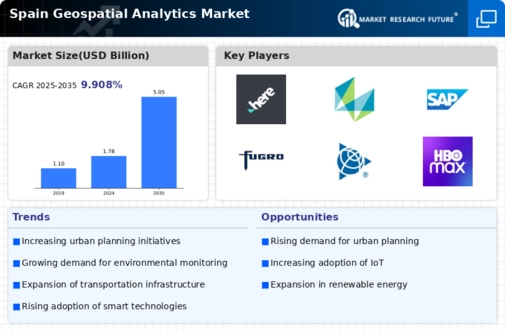Rising Demand for Location-Based Services
The geospatial analytics market in Spain experiences a notable surge in demand for location-based services. Businesses across various sectors, including retail, logistics, and tourism, increasingly rely on geospatial data to enhance operational efficiency and customer engagement. For instance, the retail sector utilizes geospatial analytics to optimize store locations and tailor marketing strategies based on consumer behavior patterns. This trend is reflected in the market's projected growth, with estimates suggesting a compound annual growth rate (CAGR) of approximately 15% over the next five years. As organizations recognize the value of spatial data in decision-making, the geospatial analytics market is poised for substantial expansion.
Emergence of Environmental Monitoring Needs
The growing awareness of environmental issues in Spain drives the demand for geospatial analytics in environmental monitoring. With climate change and urbanization posing significant challenges, stakeholders are increasingly utilizing geospatial data to assess environmental impacts and manage natural resources. The geospatial analytics market is witnessing a rise in applications related to land use planning, pollution tracking, and biodiversity conservation. Reports indicate that the market for environmental geospatial analytics could reach €1 billion by 2027, reflecting the increasing reliance on spatial data for informed decision-making. This trend underscores the critical role of geospatial technologies in addressing pressing environmental concerns.
Advancements in Satellite and Drone Technologies
Technological advancements in satellite and drone capabilities are reshaping the geospatial analytics market in Spain. The proliferation of high-resolution satellite imagery and drone-based data collection enhances the accuracy and timeliness of geospatial analyses. Industries such as agriculture, forestry, and construction are leveraging these technologies to improve productivity and resource management. For example, precision agriculture utilizes drone imagery to monitor crop health and optimize irrigation practices. The market is expected to benefit from these innovations, with projections indicating a potential increase in market size by 20% over the next few years as more sectors adopt these advanced geospatial solutions.
Government Investments in Infrastructure Development
Government initiatives in Spain aimed at infrastructure development significantly influence the geospatial analytics market. Investments in transportation, urban planning, and environmental management necessitate the use of geospatial technologies for effective project execution. The Spanish government has allocated over €10 billion for infrastructure projects in recent years, emphasizing the importance of data-driven decision-making. This investment creates opportunities for geospatial analytics firms to provide solutions that enhance project planning and execution. As public sector entities increasingly adopt geospatial tools, the market is likely to witness accelerated growth, driven by the demand for innovative solutions that support sustainable development.
Integration of Geospatial Data in Business Intelligence
The integration of geospatial data into business intelligence systems is becoming increasingly prevalent in Spain, significantly impacting the geospatial analytics market. Organizations are recognizing the value of combining traditional data with spatial information to gain deeper insights into market trends and consumer behavior. This integration allows for enhanced visualization and analysis, leading to more informed strategic decisions. As businesses invest in advanced analytics tools, the geospatial analytics market is likely to experience growth, with estimates suggesting a market expansion of approximately 12% annually. This trend highlights the importance of spatial data in driving competitive advantage across various sectors.

















Leave a Comment